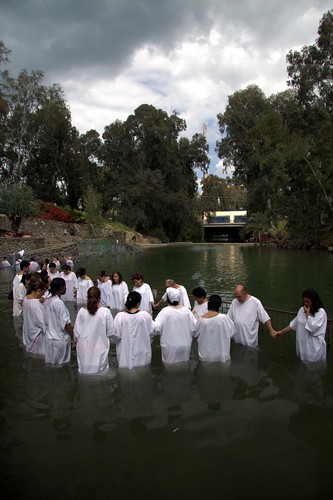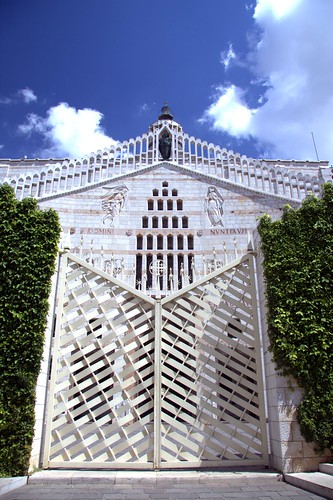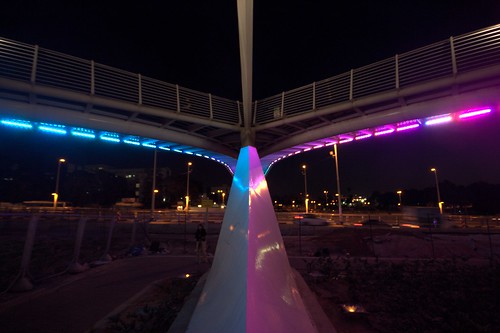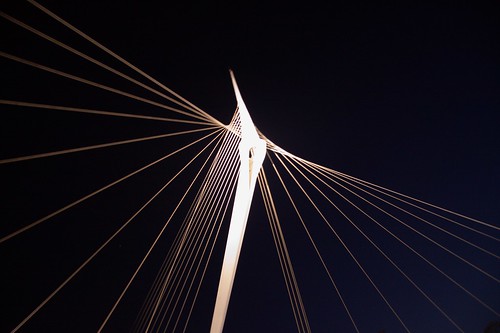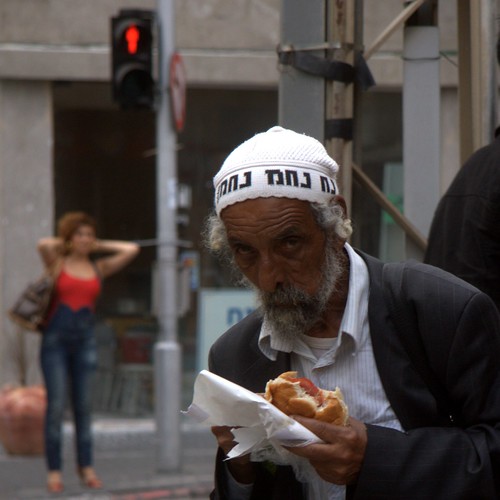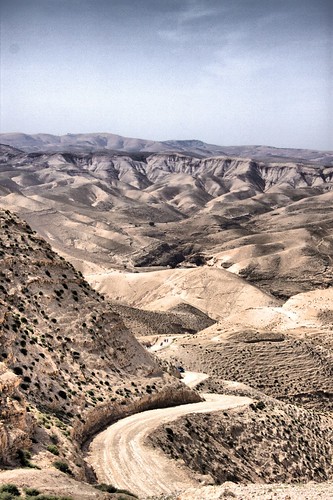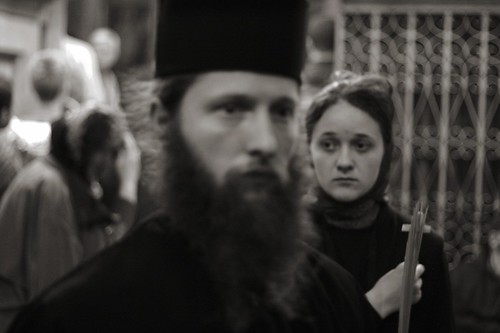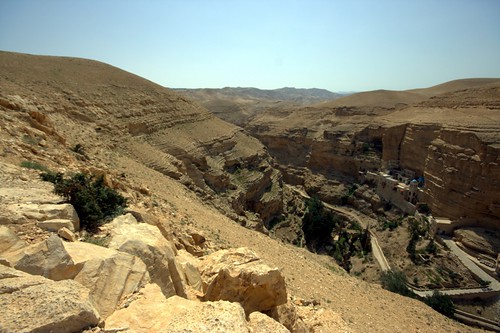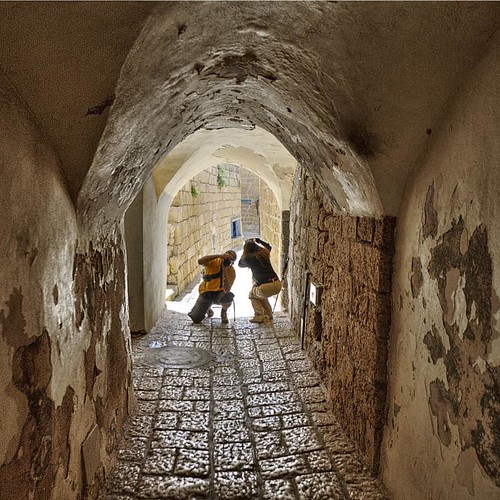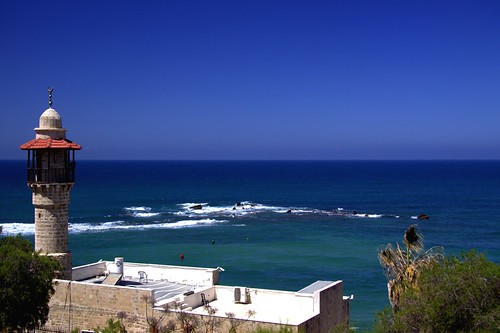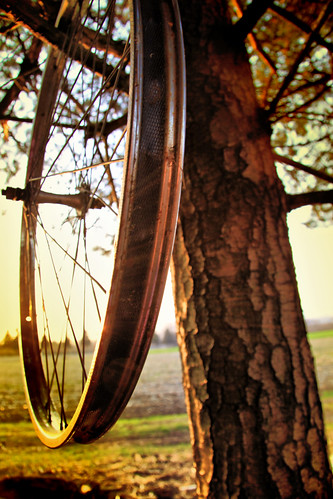© Angela M. Lobefaro
Thanks to gadihext and to his very friendly family for the fantastic hospitality!
Caesarea was originally called Straton's Tower after its founder Straton, who is believed to have been a ruler of Sidon in the 4th century BCE. In 96 BCE the city was captured by Alexander Yannai and remained in the Hasmonean kingdom until it became an autonomous city by Pompey. After being for some time in the possession of Cleopatra, ruler of Egypt, it was returned by Augustus to Herod.
Once the site of a Phoenician port, over the course of 12 years Herod built Caesarea into the grandest city other than Jerusalem in Palestine, with a deep sea harbor (called Sebastos, i.e., Augustus in Greek), aqueduct, hippodrome and magnificent amphitheater that remain standing today. Herod renamed the city Caesarea in honor of the emperor. The population of Caesarea was half gentile and half Jewish, often causing disputes among the people. In 6 CE, Caesarea became the home of the Roman governors (Procurators) of Judea. The city remained the capital of Roman and Byzantine Palestine.
www.jewishvirtuallibrary.org/jsource/vie/Caesarea.html
30 April, 2009
Cesarea Entrance
Posted by
Angela Lobefaro
at
9:30:00 PM
0
comments
![]()
29 April, 2009
Shalom
© Angela M. Lobefaro
Taken in a very cool restaurant in Galilee: the chairs are pillows!
Thanks to gadihext and to his very friendly family for the fantastic hospitality!
Posted by
Angela Lobefaro
at
10:29:00 PM
0
comments
![]()
Baptism in the River Jordan
© Angela M. Lobefaro
Thanks to gadihext and to his very friendly family for the fantastic hospitality!
Baptism in the River Jordan, Israel
In the synoptic gospels, Jesus is baptised by John the Baptist. In these accounts, John preaches repentance before the coming judgment, baptism for the forgiveness of sins, and the imminent arrival of one far greater than him. Jesus came to the Jordan River and was baptised there by John. After the baptism, the heavens open, the holy spirit like a dove descends, and a heavenly voice acclaims Jesus is his Son. Jesus then goes into the wilderness where the devil tempts him, and when he returns he begins his ministry.
en.wikipedia.org/wiki/Baptism_of_Jesus
en.wikipedia.org/wiki/Baptism
en.wikipedia.org/wiki/Jordan_River
Posted by
Angela Lobefaro
at
6:23:00 PM
0
comments
![]()
28 April, 2009
You must be in Darkness...to appreciate the Light

You must be in Darkness...to appreciate the Light, originally uploaded by ! . © Angela Lobefaro . !.
© Angela M. Lobefaro
Thanks to gadihext and to his very friendly family for the fantastic hospitality!
Basilica of the Annunciation, Nazareth, Israel
Its presence dominating the city, the Basilica of the Annunciation, maintained by the Franciscan Order, is the largest in the Middle East. The modern structure, consecrated on 23 March 1969, and designed by the architect Giovanni Muzio, consists of two levels.
www.atlastours.net/holyland/basilica_of_the_annunciation....
The lower church contains the grotto which, tradition holds, was the home of Mary and the Site of the Annunciation, along with remnants of churches from the Crusader and Byzantine eras.
en.wikipedia.org/wiki/Basilica_of_the_Annunciation
Posted by
Angela Lobefaro
at
10:18:00 PM
0
comments
![]()
Annunciation Church - Nazareth
© Angela M. Lobefaro
Thanks to gadihext and to his very friendly family for the fantastic hospitality!
Basilica of the Annunciation, Nazareth,Israel
Its presence dominating the city, the Basilica of the Annunciation, maintained by the Franciscan Order, is the largest in the Middle East. The modern structure, consecrated on 23 March 1969, and designed by the architect Giovanni Muzio, consists of two levels.
www.atlastours.net/holyland/basilica_of_the_annunciation....
The lower church contains the grotto which, tradition holds, was the home of Mary and the Site of the Annunciation, along with remnants of churches from the Crusader and Byzantine eras.
en.wikipedia.org/wiki/Basilica_of_the_Annunciation
Posted by
Angela Lobefaro
at
6:28:00 PM
0
comments
![]()
"La forma mas efectiva de crear un estado policial es declarar una emergencia sanitaria" (Hans Aumeier)

"La forma mas efectiva de crear un estado policial es declarar una emergencia sanitaria" (Hans Aumeier), originally uploaded by 9 0 0 0.
I totally agree, "fuffa" is the right word for this "new" pandemy
Posted by
Angela Lobefaro
at
11:39:00 AM
0
comments
![]()
Captain's Bridge
© Angela M. Lobefaro
Thanks to gadihext and to his very friendly family for the fantastic hospitality!
We had an amazing holiday in the Holy Land with you, and we enjoyed to learn something about the Passover, the Feast of Unleavened Bread. Also called Chag HaMatzot,the Festival of Matzah, it commemorates the Exodus and freedom of the Israelites from ancient Egypt.
Passover, the Feast of Unleavened Bread. Also called Chag HaMatzot (the Festival of Matzah), it commemorates the Exodus and freedom of the Israelites from ancient Egypt.
We hope to see you soon in Italy!
---
Taken under Calatrava String Bridge in Petach Tiqwa, Israel
listen to:
There must be another way
Posted by
Angela Lobefaro
at
10:25:00 AM
0
comments
![]()
27 April, 2009
Dream's Wing
© Angela M. Lobefaro
Thanks to gadihext and to his very friendly family for the fantastic hospitality!
Posted by
Angela Lobefaro
at
4:59:00 PM
0
comments
![]()
26 April, 2009
Massada West Side
© Angela M. Lobefaro
Taken in Massada, Israel
Thanks to gadihext and to his very friendly family for the fantastic hospitality!
Masada (Hebrew מצדה, pronounced Metzada, from מצודה, metzuda, "fortress") is the name for a site of ancient palaces and fortifications in the South District of Israel on top of an isolated rock plateau, or large mesa, on the eastern edge of the Judean Desert overlooking the Dead Sea. After the First Jewish-Roman War (also known as the Great Jewish Revolt) a siege of the fortress by troops of the Roman Empire led to the mass suicide of Jewish rebels, who preferred death to surrender.
en.wikipedia.org/wiki/Masada
Posted by
Angela Lobefaro
at
4:05:00 PM
0
comments
![]()
Do NOT Listen to Street's Sirens
© Angela M. Lobefaro
Posted by
Angela Lobefaro
at
12:13:00 PM
0
comments
![]()
25 April, 2009
Timna Valley (Available for licensing and purchase)
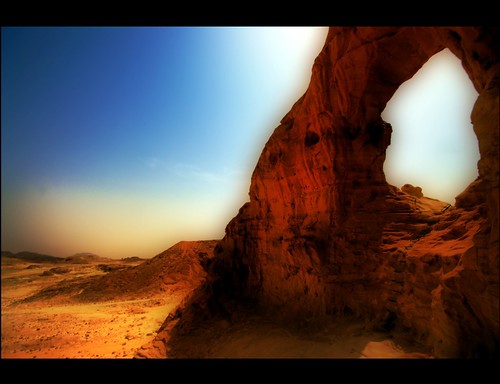
Timna Valley (Available for licensing and purchase), originally uploaded by ! . © Angela Lobefaro . !.
© Angela M. Lobefaro
Thanks to gadihext and to his very friendly family for the fantastic hospitality!
The Timna Valley is located in southern Israel in the southwestern Arabah, approximately 30 km (18.6 mi) north of the Gulf of Aqaba and the town of Eilat. The area is rich in copper ore, and has been actively mined by humans since the 6th millennium BCE.
en.wikipedia.org/wiki/Timna_valley
Posted by
Angela Lobefaro
at
9:30:00 AM
0
comments
![]()
24 April, 2009
Its a long and winding road
© Angela M. Lobefaro
Thanks to gadihext and to his very friendly family for the fantastic hospitality!
The Monastery of St. George clings to the canyon walls like a fairy-tale castle . Of all the monasteries founded in this spectacularly austere area between the 4th and 7th centuries AD, it is the only survivor. The first monks to settle as hermits in the caves in this part of the wadi were named Prono, Elias, Gannaios, Ainan and Zenon (about 420 AD). The monastery itself, dedicated to the Virgin Mary, was founded by St. John of Thebes (about 480 AD) as a spiritual center for the hermits of the region. Supposedly it was built over a cave where Joachin took refuge to lament the infertility of his wife, Anna. An angel told him to return to Anna, who afterward gave birth to the Virgin Mary. In the 6th century AD the monastery became known as St. George under the leadership of George of Koziba.
Born in Cyprus about 550 AD, George lived for a time in Jordan, but later an intense longing for a more ascetic life brought him to the Wadi Kelt. During the Persian invasion of Palestine in 614 AD, the monastery was destroyed and many of its monks were killed. A Greek-Arabic inscription above the old entrance testifies to its reconstruction by Crusaders in 1179. But most of the present monastery dates back to a 1879-1901 reconstruction by the Greek Orthodox Church. The oldest part of the building is the 6th century AD mosaic floor of the neighboring Church of St. John. The skulls of the monks martyred by the Persians are kept here and a niche contains the tomb of St. George.
www.welcometohosanna.com/LIFE_OF_JESUS/wadikelt2.htm
The Beatles - The Long and Winding Road
Posted by
Angela Lobefaro
at
2:41:00 PM
0
comments
![]()
Francescan Profile
© Angela M. Lobefaro
Thanks to gadihext and to his very friendly family for the fantastic hospitality!
The Church of the Holy Sepulchre (Latin: Sanctum Sepulchrum), also called the Church of the Resurrection (Greek: Ναός της Αναστάσεως, Naos tis Anastaseos; Arabic: كنيسة القيامة, Kanīsat al-Qiyāma; Armenian: Սուրբ Հարություն, Surp Harutyun) by Eastern Christians, is a Christian church within the walled Old City of Jerusalem.
The site is venerated by most Christians as Golgotha,[1] (the Hill of Calvary), where the New Testament says that Jesus was crucified,[2] and is said to also contain the place where Jesus was buried (the sepulchre). The church has been an important pilgrimage destination since at least the 4th century, as the purported site of the death and resurrection of Jesus. Today it also serves as the headquarters of the Greek Orthodox Patriarch of Jerusalem, while control of the building is shared between several Christian churches and secular entities in complicated arrangements essentially unchanged for centuries.
en.wikipedia.org/wiki/Church_of_the_Holy_Sepulchre
Posted by
Angela Lobefaro
at
9:36:00 AM
0
comments
![]()
22 April, 2009
Jerusalem People... maybe
© Angela M. Lobefaro
Thanks to gadihext and to his very friendly family for the fantastic hospitality!
The Church of the Holy Sepulchre (Latin: Sanctum Sepulchrum), also called the Church of the Resurrection (Greek: Ναός της Αναστάσεως, Naos tis Anastaseos; Arabic: كنيسة القيامة, Kanīsat al-Qiyāma; Armenian: Սուրբ Հարություն, Surp Harutyun) by Eastern Christians, is a Christian church within the walled Old City of Jerusalem.
The site is venerated by most Christians as Golgotha,[1] (the Hill of Calvary), where the New Testament says that Jesus was crucified,[2] and is said to also contain the place where Jesus was buried (the sepulchre). The church has been an important pilgrimage destination since at least the 4th century, as the purported site of the death and resurrection of Jesus. Today it also serves as the headquarters of the Greek Orthodox Patriarch of Jerusalem, while control of the building is shared between several Christian churches and secular entities in complicated arrangements essentially unchanged for centuries.
en.wikipedia.org/wiki/Church_of_the_Holy_Sepulchre
Posted by
Angela Lobefaro
at
11:06:00 PM
0
comments
![]()
St. George of Koziba Monastery
© Angela M. Lobefaro
Thanks to gadihext and to his very friendly family for the fantastic hospitality!
The Monastery of St. George clings to the canyon walls like a fairy-tale castle . Of all the monasteries founded in this spectacularly austere area between the 4th and 7th centuries AD, it is the only survivor. The first monks to settle as hermits in the caves in this part of the wadi were named Prono, Elias, Gannaios, Ainan and Zenon (about 420 AD). The monastery itself, dedicated to the Virgin Mary, was founded by St. John of Thebes (about 480 AD) as a spiritual center for the hermits of the region. Supposedly it was built over a cave where Joachin took refuge to lament the infertility of his wife, Anna. An angel told him to return to Anna, who afterward gave birth to the Virgin Mary. In the 6th century AD the monastery became known as St. George under the leadership of George of Koziba.
Born in Cyprus about 550 AD, George lived for a time in Jordan, but later an intense longing for a more ascetic life brought him to the Wadi Kelt. During the Persian invasion of Palestine in 614 AD, the monastery was destroyed and many of its monks were killed. A Greek-Arabic inscription above the old entrance testifies to its reconstruction by Crusaders in 1179. But most of the present monastery dates back to a 1879-1901 reconstruction by the Greek Orthodox Church. The oldest part of the building is the 6th century AD mosaic floor of the neighboring Church of St. John. The skulls of the monks martyred by the Persians are kept here and a niche contains the tomb of St. George.
www.welcometohosanna.com/LIFE_OF_JESUS/wadikelt2.htm
Posted by
Angela Lobefaro
at
9:33:00 PM
0
comments
![]()
Two great photographers in action
Two great photographers in action by GadiHext.
Are you shooting me? well I don't see anybody else around!
I was privileged to have Angela Lobefaro and max with me here in israel for 10 days!!!
Posted by
Angela Lobefaro
at
6:41:00 PM
0
comments
![]()
21 April, 2009
Church of the Holy Sepulchre
© Angela M. Lobefaro
Thanks to gadihext and to his very friendly family for the fantastic hospitality!
The Church of the Holy Sepulchre (Latin: Sanctum Sepulchrum), also called the Church of the Resurrection (Greek: Ναός της Αναστάσεως, Naos tis Anastaseos; Arabic: كنيسة القيامة, Kanīsat al-Qiyāma; Armenian: Սուրբ Հարություն, Surp Harutyun) by Eastern Christians, is a Christian church within the walled Old City of Jerusalem.
The site is venerated by most Christians as Golgotha,[1] (the Hill of Calvary), where the New Testament says that Jesus was crucified,[2] and is said to also contain the place where Jesus was buried (the sepulchre). The church has been an important pilgrimage destination since at least the 4th century, as the purported site of the death and resurrection of Jesus. Today it also serves as the headquarters of the Greek Orthodox Patriarch of Jerusalem, while control of the building is shared between several Christian churches and secular entities in complicated arrangements essentially unchanged for centuries.
en.wikipedia.org/wiki/Church_of_the_Holy_Sepulchre
Posted by
Angela Lobefaro
at
11:16:00 AM
0
comments
![]()
19 April, 2009
Jaffa
© Angela M. Lobefaro
Thanks to gadihext and to his very friendly family for the fantastic hospitality!
We had an amazing holiday in the Holy Land with you, and we enjoyed to learn something about the Passover, the Feast of Unleavened Bread. Also called Chag HaMatzot,the Festival of Matzah, it commemorates the Exodus and freedom of the Israelites from ancient Egypt.
Passover, the Feast of Unleavened Bread. Also called Chag HaMatzot (the Festival of Matzah), it commemorates the Exodus and freedom of the Israelites from ancient Egypt.
We hope to see you soon in Italy!
Posted by
Angela Lobefaro
at
1:19:00 PM
0
comments
![]()
18 April, 2009
Bnei Brak
© Angela M. Lobefaro
Thanks to Gadihext and his family for the fantastic hospitality, we hope to see you soon in Italy!
Bnei Brak (or Bene Beraq) (Hebrew: בְּנֵי בְּרַק Bnei brak.ogg (audio) (help·info), Bəne Bəraq) is a city located on Israel's central Mediterranean coastal plain, just east of Tel Aviv, in the Dan metropolitan region and Tel Aviv District. It is the only large city in Israel whose population comprises predominantly Haredi Jews.
en.wikipedia.org/wiki/Bnei_Brak
The methods of koshering include the following:
Libun is used for items heated directly on a fire, such as a grill, baking pans used in an oven, or frying pans used to heat oil. The word libun means "purify" and comes from the same Hebrew root word for "white." There are two types of libun:
1) Libun Gamur, "complete purification." When the term libun is used by itself, this is the kind of libun being referred to. Libun means heating a pan or grill until it is red hot. To heat pans until they are red hot usually requires a blowtorch, as your standard oven does not reach temperatures that are hot enough, and this is a procedure most often performed by a rabbi.
2) Libun Kal, "simple purification." Heating metal hot enough that paper (traditionally, a broom straw) touching it scorches. When an oven goes through a self-cleaning cycle, it gets this hot. This is a method you might use on a frying pan.
Hag'alah, "scouring" or "scalding," is used for items such as pots or flatware that have become treif through contact with hot liquids. Hag'alah means kashering the item in a large pot of boiling water.
Irui, "infusion," is kashering by pouring boiling water over something, a method used for countertops and sinks.
www.myjewishlearning.com/practices/Ritual/Kashrut_Dietary...
Posted by
Angela Lobefaro
at
7:55:00 AM
0
comments
![]()
04 April, 2009
Hello, Hi there!
© Angela M. Lobefaro
We are BUSY ...Getting Ready for a Trip!
See you soon dear flickr friends!
ஐHAPPY ஐEASTER ஐto you ஐALLஐ
;-)
Posted by
Angela Lobefaro
at
10:20:00 PM
0
comments
![]()
01 April, 2009
End Of The Road
© Angela M. Lobefaro
The car, whose first generation was designed by Frank Stephenson,[1] is drawing inspiration from the original Mini, which was manufactured by the British Motor Corporation and its successors from 1959 to 2000. The name of the car's brand, MINI, is all-capitalized to distinguish it from its predecessor.[2]
2003 Mini Cooper S and Mk III classic Mini.
The development of the first generation had been done between 1995 and 2001 by Rover Group in Gaydon, United Kingdom and BMW AG in Munich, Germany and was accompanied by continual contention between Rover and BMW. Especially the positioning of the car was contended. Rover wanted an economy car, whilst BMW supported a small sporting car and finally prevailed. In 1999 BMW assumed control over the whole project after BMW's CEO Bernd Pischetsrieder had left the company. [3] When BMW divested itself of Rover in 2000, BMW decided to keep the Mini project and to build the car, which was originally to be built at Rover's Longbridge plant, [3] the former production plant of the traditional Mini, at BMW's Oxford plant in Cowley, Oxford, United Kingdom, in what was historically the Pressed Steel Company body plant. [4]
The 2001 to 2006 model years included four hatchback models: the basic "Mini One", the diesel-engined "Mini One/D", the sportier "Mini Cooper" and the supercharged "Mini Cooper S". In 2005 a convertible roof option was added. In November 2006 BMW released a re-engineered version of the Mini which is unofficially known as the "Mk II Mini".[5] The Mk II is currently[update] available as a hatchback and a wagon (Clubman). The convertible was still based on the MK 1 until January 2009. Now, it is based on the MK 2.
The Mini was designed and engineered to replace the long running Rover 100 and the larger Rover 200, both deemed unsuitable for the modern world automobile market. The Mini was supposed to replace low-end models of the 200 and high-end models of the 100 with a Rover 35 replacing high end 200s and low end 400s. After the divestment of MG Rover, the Mini was instead marketed as a small yet desirable city car rather than a mainstream replacement of the 100 and 200.
en.wikipedia.org/wiki/Mini_(BMW)
Posted by
Angela Lobefaro
at
11:15:00 PM
0
comments
![]()
Oddity
"Only two things are infinite, the universe and human stupidity, and I'm not sure about the former."
-- Albert Einstein
from quotedb
Posted by
Angela Lobefaro
at
2:04:00 PM
0
comments
![]()


